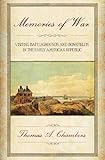Memories of War : Visiting Battlegrounds and Bonefields in the Early American Republic / Thomas A. Chambers.
Material type: TextPublisher: Ithaca, NY : Cornell University Press, [2012]Copyright date: ©2012Description: 1 online resource (252 p.) : 20 halftones, 6 maps, 3 tablesContent type:
TextPublisher: Ithaca, NY : Cornell University Press, [2012]Copyright date: ©2012Description: 1 online resource (252 p.) : 20 halftones, 6 maps, 3 tablesContent type: - 9780801465673
- Battlefields -- History -- 18th century -- United States
- Battlefields -- History -- 19th century -- United States
- Battlefields -- United States -- History -- 18th century
- Battlefields -- United States -- History -- 19th century
- Cemeteries -- History -- 19th century -- United States
- Cemeteries -- United States -- History -- 19th century
- Collective memory -- History -- 19th century -- United States
- Collective memory -- United States -- History -- 19th century
- Heritage tourism -- History -- 19th century -- United States
- Heritage tourism -- United States -- History -- 19th century
- Memorialization -- History -- 19th century -- United States
- Memorialization -- United States -- History -- 19th century
- Military History
- Travel Guides & Travel Writing
- U.S. History
- HISTORY / United States / 19th Century
- battle site tourism, american military history, cultural history, civil war sites, revolutionary war battlegrounds, national history, hudson river valley, southern war sites
- 355.00973 23/eng/20230216
- online - DeGruyter
| Item type | Current library | Call number | URL | Status | Notes | Barcode | |
|---|---|---|---|---|---|---|---|
 eBook
eBook
|
Biblioteca "Angelicum" Pont. Univ. S.Tommaso d'Aquino Nuvola online | online - DeGruyter (Browse shelf(Opens below)) | Online access | Not for loan (Accesso limitato) | Accesso per gli utenti autorizzati / Access for authorized users | (dgr)9780801465673 |
Frontmatter -- Contents -- List of Illustrations -- Preface -- Introduction: The Changing Nature of Battlefield Tourism and Commemoration -- 1. Accidental Tourists: The Bonefields of Braddock’s Defeat and Ticonderoga -- 2. Forsaken Graves: The Emergence of Memory on the Northern Tour -- 3. Retrieved Relics and New Monuments: Lafayette in Yorktown -- 4. Memory without Tourism: Traces of the Southern Campaigns -- 5. American Antiquities Are So Rare: Remembering the War of 1812 on the Niagara Frontier -- 6. The Value of Union: Antebellum Commemoration and the Coming of the Civil War -- Notes -- Index
restricted access online access with authorization star
http://purl.org/coar/access_right/c_16ec
Even in the midst of the Civil War, its battlefields were being dedicated as hallowed ground. Today, those sites are among the most visited places in the United States. In contrast, the battlegrounds of the Revolutionary War had seemingly been forgotten in the aftermath of the conflict in which the nation forged its independence. Decades after the signing of the Constitution, the battlefields of Yorktown, Saratoga, Fort Moultrie, Ticonderoga, Guilford Courthouse, Kings Mountain, and Cowpens, among others, were unmarked except for crumbling forts and overgrown ramparts. Not until the late 1820s did Americans begin to recognize the importance of these places. In Memories of War, Thomas A. Chambers recounts America’s rediscovery of its early national history through the rise of battlefield tourism in the first half of the nineteenth century. Travelers in this period, Chambers finds, wanted more than recitations of regimental movements when they visited battlefields; they desired experiences that evoked strong emotions and leant meaning to the bleached bones and decaying fortifications of a past age. Chambers traces this impulse through efforts to commemorate Braddock’s Field and Ticonderoga, the cultivated landscapes masking the violent past of the Hudson River valley, the overgrown ramparts of Southern war sites, and the scenic vistas at War of 1812 battlefields along the Niagara River. Describing a progression from neglect to the Romantic embrace of the landscape and then to ritualized remembrance, Chambers brings his narrative up to the beginning of the Civil War, during and after which the memorialization of such sites became routine, assuming significant political and cultural power in the American imagination.
Mode of access: Internet via World Wide Web.
In English.
Description based on online resource; title from PDF title page (publisher's Web site, viewed 26. Apr 2024)


